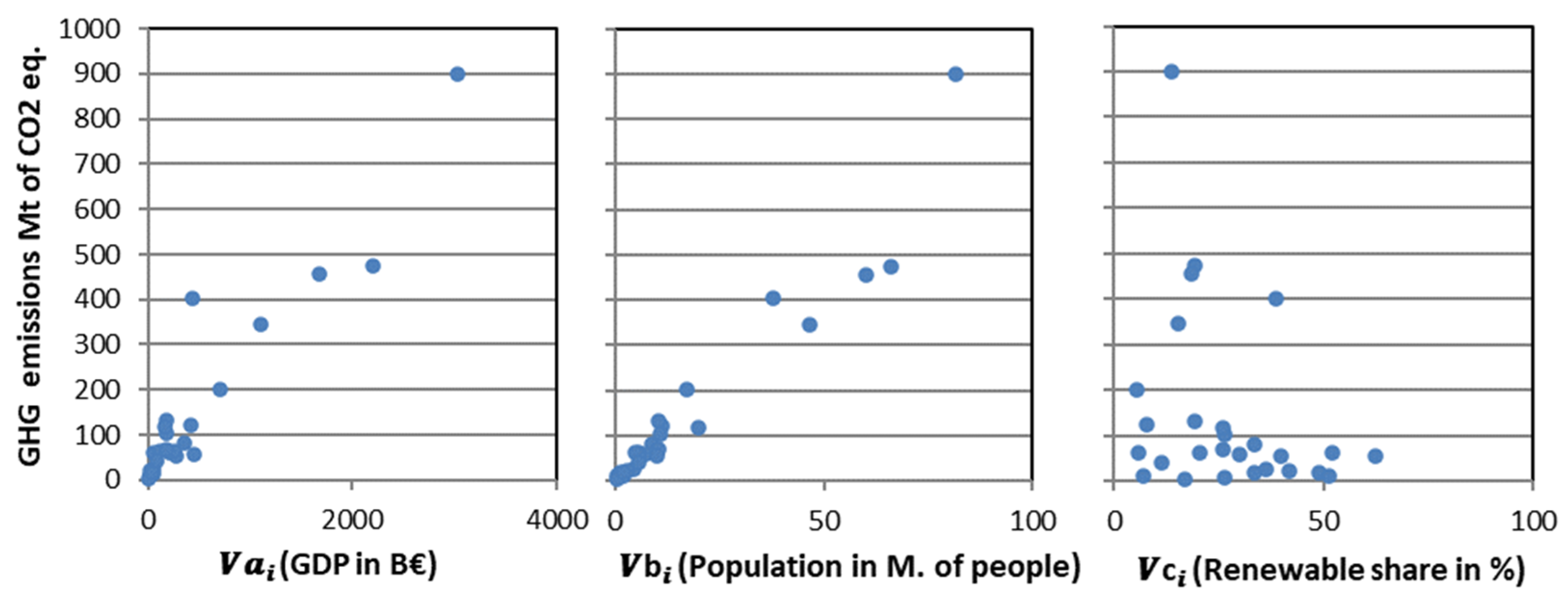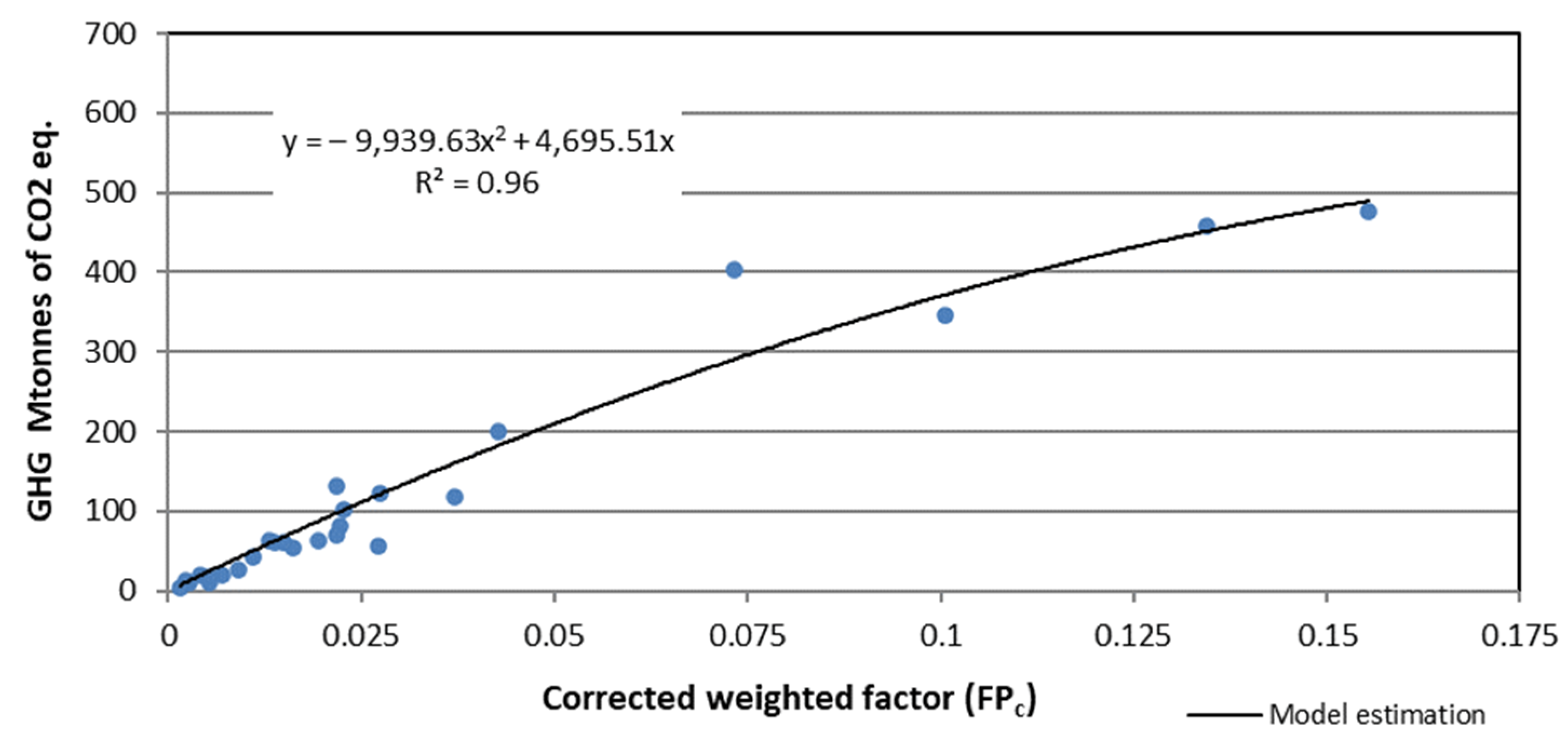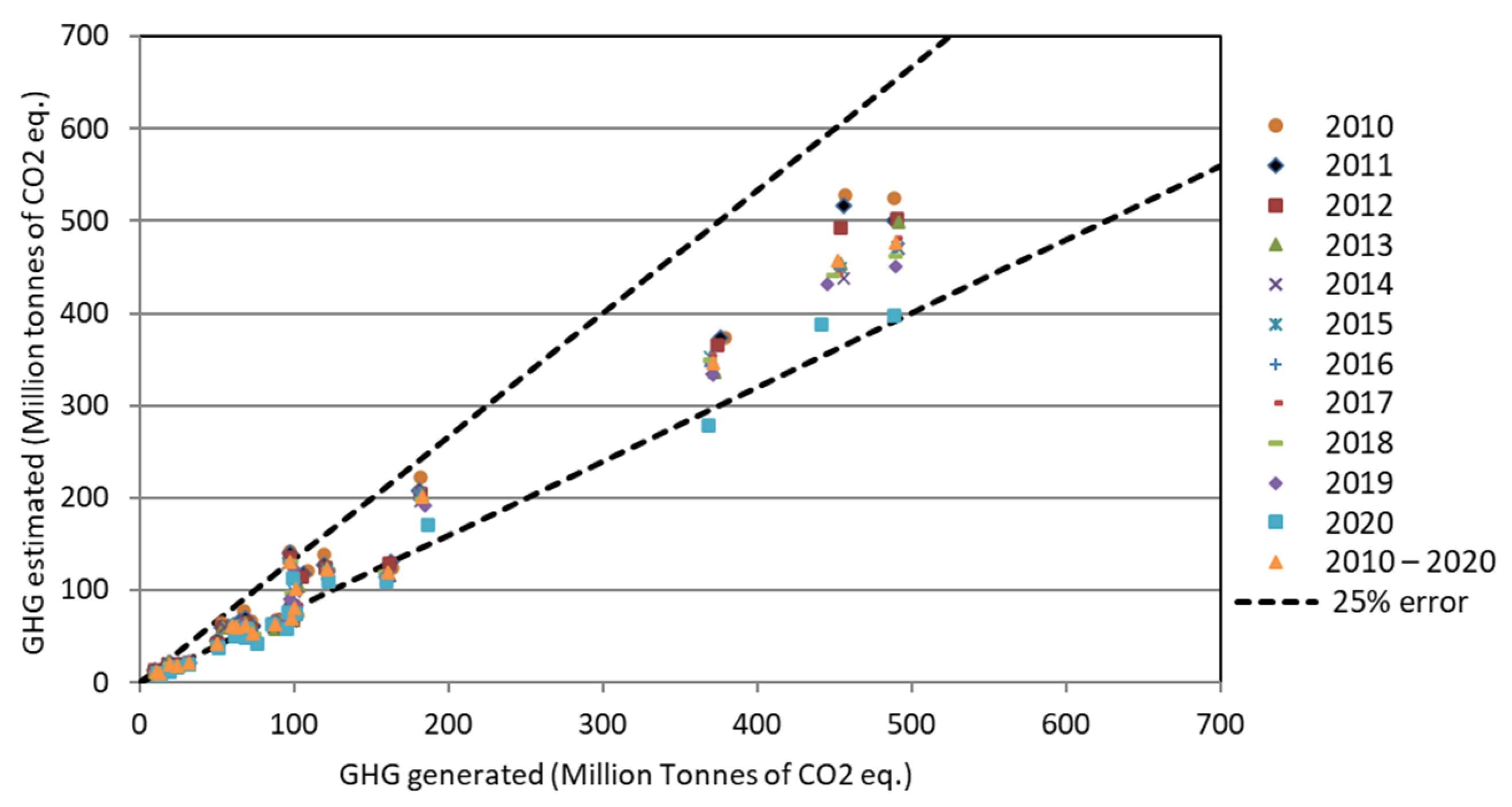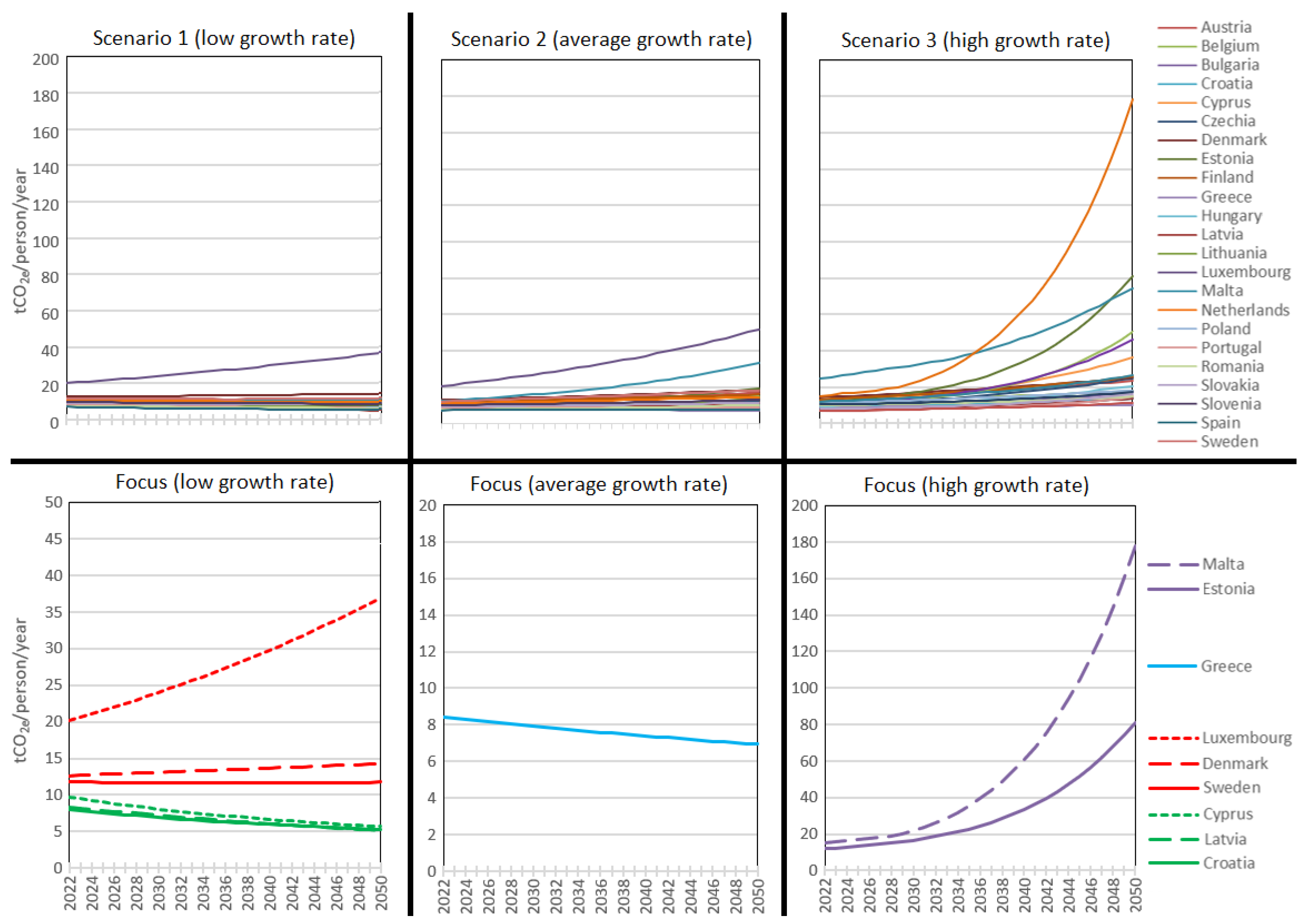Greenhouse Gas Emissions Forecasts in Countries of the European Union by Means of a Multifactor Algorithm
Abstract
1. Introduction
2. Materials and Methods
- Independent variables and data collection.
- Relationship of independent variables with GHGs.
- Algorithm development and validation.
- Future forecast scenarios.
2.1. Independent Variables and Data Collection
2.2. Relationship of Independent Variables with GHGs
2.3. Algorithm Development and Validation
- is the analysed variable (GDP “a”, population “b” or RES “c”);
- is the analysed MS (n = 1, 2, 3, 4, 5, 6 … 27);
- is the value of the variable for the analysed MS “”;
- is the weighting value of each variable for the analysed MS ”.
- is the amount of GHG emissions estimated for the MS “”;
- is the coefficient that represents how changes in each of the independent variables “” () influence the dependent variable “”;
- is the residual error, i.e., difference between the observed values () and those estimated by the model of the dependent variable () (Equation (3)).
- is the corrected weighting value for the MS “”.
2.4. Future Forecast Scenarios
3. Results
3.1. Algorithm and Validation
3.1.1. Weighted Values
- is the GDP in billion euros of the additional country ();
- is the population in millions of people of the additional country ();
- is the RES in percentage of the additional country ();
- is the weighting factor corresponding to the GDP of the additional country ();
- is the weighting factor corresponding to the population of the additional country ();
- is the weighting factor corresponding to the RES of the additional country ();
- is the weighting value of each variable for the analysed MS ”.
3.1.2. Standardised Coefficients
3.1.3. Corrected Weighted Factors (FPc)
- is the corrected weighting factor.
3.1.4. Final Algorithm and Validation
3.2. Future Forecast of GHG Emissions
4. Discussion and Conclusions
Author Contributions
Funding
Institutional Review Board Statement
Informed Consent Statement
Data Availability Statement
Conflicts of Interest
References
- Ledley, T.S.; Sundquist, E.T.; Schwartz, S.E.; Hall, D.K.; Fellows, J.D.; Killeen, T.L. Climate Change and Greenhouse Gases. Eos Trans. Am. Geophys. Union 1999, 80, 453–458. [Google Scholar] [CrossRef]
- Santana, J.C.C.; Miranda, A.C.; Yamamura, C.L.K.; da Silva Filho, S.C.; Tambourgi, E.B.; Lee Ho, L.; Berssaneti, F.T. Effects of Air Pollution on Human Health and Costs: Current Situation in São Paulo, Brazil. Sustainability 2020, 12, 4875. [Google Scholar] [CrossRef]
- Ma, Q. NASA GISS: Science Briefs: Greenhouse Gases: Refining the Role of Carbon Dioxide. Available online: https://www.giss.nasa.gov/research/briefs/1998_ma_01/ (accessed on 19 August 2022).
- Florides, G.A.; Christodoulides, P. Global Warming and Carbon Dioxide through Sciences. Environ. Int. 2009, 35, 390–401. [Google Scholar] [CrossRef] [PubMed]
- Masson-Delmotte, V.; Zhai, P.; Pörtner, H.-O.; Roberts, D.; Skea, J.; Shukla, P. Global Warming of 1.5 °C. In An IPCC Special Report on the Impacts of Global Warming of 1.5 °C above Pre-Industrial Levels and Related Global Greenhouse Gas Emission Pathways; 2018; p. 616. Available online: https://www.ipcc.ch/site/assets/uploads/sites/2/2019/06/SR15_Full_Report_Low_Res.pdf (accessed on 19 August 2022).
- Tiseo, I. Annual CO2 Emissions Worldwide 1940–2020. Available online: https://www.statista.com/statistics/276629/global-co2-emissions/ (accessed on 27 August 2022).
- Ritchie, H.; Roser, M.; Rosado, P. CO2 and Greenhouse Gas Emissions. Our World Data. 2020. Available online: https://ourworldindata.org/co2-and-greenhouse-gas-emissions (accessed on 19 August 2022).
- Tiseo, I. EU Carbon Dioxide Emissions. Available online: https://www.statista.com/statistics/450017/co2-emissions-europe-eurasia/ (accessed on 27 August 2022).
- Maizland, L. Global Climate Agreements: Successes and Failures. Available online: https://www.cfr.org/backgrounder/paris-global-climate-change-agreements (accessed on 27 August 2022).
- European Commission. Directive (EU) 2018/2002 of the European Parliament and of the Council of 11 December 2018 Amending Directive 2012/27/EU on Energy Efficiency (Text with EEA Relevance). 2018. Available online: https://eur-lex.europa.eu/legal-content/EN/TXT/PDF/?uri=CELEX:32018L2002&rid=7 (accessed on 19 August 2022).
- European Commission. Stepping Up Europe’s 2030 Climate Ambition Investing in a Climate-Neutral Future for the Benefit of Our People. 2020. Available online: https://knowledge4policy.ec.europa.eu/publication/communication-com2020562-stepping-europe%E2%80%99s-2030-climate-ambition-investing-climate_en (accessed on 19 August 2022).
- Santana, J.C.C.; Machado, P.G.; Nascimento, C.A.O.D.; Ribeiro, C.D.O. Economic and Environmental Assessment of Hydrogen Production from Brazilian Energy Grid. Energies 2023, 16, 3769. [Google Scholar] [CrossRef]
- Ślusarczyk, B.; Żegleń, P.; Kluczek, A.; Nizioł, A.; Górka, M. The Impact of Renewable Energy Sources on the Economic Growth of Poland and Sweden Considering COVID-19 Times. Energies 2022, 15, 332. [Google Scholar] [CrossRef]
- Keppler, J.H.; Mansanet-Bataller, M. Causalities between CO2, Electricity, and Other Energy Variables during Phase I and Phase II of the EU ETS. Energy Policy 2010, 38, 3329–3341. [Google Scholar] [CrossRef]
- Cai, W.; Pan, J. Stochastic Differential Equation Models for the Price of European CO2 Emissions Allowances. Sustainability 2017, 9, 207. [Google Scholar] [CrossRef]
- Cucchiella, F.; D’Adamo, I.; Gastaldi, M.; Koh, L.; Santibanez-Gonzalez, E.D.R. Assessment of Ghg Emissions in Europe: Future Estimates and Policy Implications. Environ. Eng. Manag. J. 2020, 19, 131–142. [Google Scholar]
- European Commission. Carbon Border Adjustment Mechanism. Available online: https://taxation-customs.ec.europa.eu/green-taxation-0/carbon-border-adjustment-mechanism_en (accessed on 28 January 2023).
- Stiglitz, J.; Stern, N. Report of the High-Level Commission on Carbon Prices. Available online: https://www.carbonpricingleadership.org/report-of-the-highlevel-commission-on-carbon-prices (accessed on 28 January 2023).
- Huusko, H. Set Science-Based Emission Reduction Targets | UN Global Compact. Available online: https://www.unglobalcompact.org/take-action/action/science-based-target (accessed on 27 August 2022).
- Marotta, A.; Porras-Amores, C.; Rodríguez Sánchez, A. Are Green Buildings an Indicator of Sustainable Development? Appl. Sci. 2023, 13, 3005. [Google Scholar] [CrossRef]
- Vasylieva, T.; Lyulyov, O.; Bilan, Y.; Streimikiene, D. Sustainable Economic Development and Greenhouse Gas Emissions: The Dynamic Impact of Renewable Energy Consumption, GDP, and Corruption. Energies 2019, 12, 3289. [Google Scholar] [CrossRef]
- Simionescu, M.; Păuna, C.B.; Niculescu, M.-D.V. The Relationship between Economic Growth and Pollution in Some New European Union Member States: A Dynamic Panel ARDL Approach. Energies 2021, 14, 2363. [Google Scholar] [CrossRef]
- Fakher, H.A.; Inglesi-Lotz, R. Revisiting Environmental Kuznets Curve: An Investigation of Renewable and Non-Renewable Energy Consumption Role. Environ. Sci. Pollut. Res. 2022, 29, 87583–87601. [Google Scholar] [CrossRef] [PubMed]
- Leitão, N.C.; Lorente, D.B. The Linkage between Economic Growth, Renewable Energy, Tourism, CO2 Emissions, and International Trade: The Evidence for the European Union. Energies 2020, 13, 4838. [Google Scholar] [CrossRef]
- Busu, M. Analyzing the Impact of the Renewable Energy Sources on Economic Growth at the EU Level Using an ARDL Model. Mathematics 2020, 8, 1367. [Google Scholar] [CrossRef]
- Bölük, G.; Mert, M. Fossil & Renewable Energy Consumption, GHGs (Greenhouse Gases) and Economic Growth: Evidence from a Panel of EU (European Union) Countries. Energy 2014, 74, 439–446. [Google Scholar] [CrossRef]
- Altıntaş, H.; Kassouri, Y. Is the Environmental Kuznets Curve in Europe Related to the Per-Capita Ecological Footprint or CO2 Emissions? Ecol. Indic. 2020, 113, 106187. [Google Scholar] [CrossRef]
- Rehman, E.; Rehman, S. Modeling the Nexus between Carbon Emissions, Urbanization, Population Growth, Energy Consumption, and Economic Development in Asia: Evidence from Grey Relational Analysis. Energy Rep. 2022, 8, 5430–5442. [Google Scholar] [CrossRef]
- Vormittag, E.M.; Rodrigues, C.G.; André, P.A.D.; Saldiva, P.H.N. Assessment and Valuation of Public Health Impacts from Gradual Biodiesel Implementation in the Transport Energy Matrix in Brazil. Aerosol Air Qual. Res. 2018, 18, 2375–2382. [Google Scholar] [CrossRef]
- Villoria Sáez, P.; Porras-Amores, C.; del Río Merino, M. New Quantification Proposal for Construction Waste Generation in New Residential Constructions. J. Clean. Prod. 2015, 102, 58–65. [Google Scholar] [CrossRef]
- de Souza Mendonça, A.K.; Barni, G.D.A.C.; Moro, M.F.; Bornia, A.C.; Kupek, E.; Fernandes, L. Hierarchical Modeling of the 50 Largest Economies to Verify the Impact of GDP, Population and Renewable Energy Generation in CO2 Emissions. Sustain. Prod. Consum. 2020, 22, 58–67. [Google Scholar] [CrossRef]
- Sahlian, D.N.; Popa, A.F.; Creţu, R.F. Does the Increase in Renewable Energy Influence GDP Growth? An EU-28 Analysis. Energies 2021, 14, 4762. [Google Scholar] [CrossRef]
- Oei, P.-Y.; Hermann, H.; Herpich, P.; Holtemöller, O.; Lünenbürger, B.; Schult, C. Coal Phase-out in Germany—Implications and Policies for Affected Regions. Energy 2020, 196, 117004. [Google Scholar] [CrossRef]
- Alola, A.A.; Yalçiner, K.; Alola, U.V.; Akadiri, S.S. The Role of Renewable Energy, Immigration and Real Income in Environmental Sustainability Target. Evidence from Europe Largest States. Sci. Total Environ. 2019, 674, 307–315. [Google Scholar] [CrossRef]
- Marotta, A.; Porras-Amores, C.; Rodríguez Sánchez, A. Resilient Built Environment: Critical Review of the Strategies Released by the Sustainability Rating Systems in Response to the COVID-19 Pandemic. Sustainability 2021, 13, 11164. [Google Scholar] [CrossRef]
- González-Sánchez, M.; Martín-Ortega, J.L. Greenhouse Gas Emissions Growth in Europe: A Comparative Analysis of Determinants. Sustainability 2020, 12, 1012. [Google Scholar] [CrossRef]
- Simionescu, M.; Strielkowski, W.; Tvaronavičienė, M. Renewable Energy in Final Energy Consumption and Income in the EU-28 Countries. Energies 2020, 13, 2280. [Google Scholar] [CrossRef]
- Rubins, M.; Pilvere, I. Development of Renewable Energy Policy in Latvia. In Proceedings of the International Scientific Conference, Jelgava, Latvia, 4–5 May 2017. [Google Scholar]
- Simionescu, M.; Bilan, Y.; Krajňáková, E.; Streimikiene, D.; Gędek, S. Renewable Energy in the Electricity Sector and GDP per Capita in the European Union. Energies 2019, 12, 2520. [Google Scholar] [CrossRef]
- Ntanos, S.; Skordoulis, M.; Kyriakopoulos, G.; Arabatzis, G.; Chalikias, M.; Galatsidas, S.; Batzios, A.; Katsarou, A. Renewable Energy and Economic Growth: Evidence from European Countries. Sustainability 2018, 10, 2626. [Google Scholar] [CrossRef]
- Karmellos, M.; Kosmadakis, V.; Dimas, P.; Tsakanikas, A.; Fylaktos, N.; Taliotis, C.; Zachariadis, T. A Decomposition and Decoupling Analysis of Carbon Dioxide Emissions from Electricity Generation: Evidence from the EU-27 and the UK. Energy 2021, 231, 120861. [Google Scholar] [CrossRef]
- Fotis, P. Sustainable Development and Competition: New Evidence from EU Countries. E3S Web Conf. 2021, 296, 06045. [Google Scholar] [CrossRef]
- Oyebanji, M.O.; Kirikkaleli, D. Energy Productivity and Environmental Deregulation: The Case of Greece. Environ. Sci. Pollut. Res. 2022, 29, 82772–82784. [Google Scholar] [CrossRef] [PubMed]
- Stamopoulos, D.; Dimas, P.; Sebos, I.; Tsakanikas, A. Does Investing in Renewable Energy Sources Contribute to Growth? A Preliminary Study on Greece’s National Energy and Climate Plan. Energies 2021, 14, 8537. [Google Scholar] [CrossRef]
- Loumakis, S.; Giannini, E.; Maroulis, Z. Renewable Energy Sources Penetration in Greece: Characteristics and Seasonal Variation of the Electricity Demand Share Covering. Energies 2019, 12, 2441. [Google Scholar] [CrossRef]
- Kosmopoulos, P.; Kantzioura, A.; Kosmopoulos, I.; Kleskas, K.; Kosmopoulos, A. Public Opinion in Greece about Photovoltaics & Renewable Energy Sources; Skiathos Island, Greece. Available online: https://www.researchgate.net/publication/354067042_PUBLIC_OPINION_IN_GREECE_ABOUT_PHOTOVOLTAICS_RENEWABLE_ENERGY_SOURCES (accessed on 23 August 2021).
- Poljanskihh, A.; Levina, A.; Dubgorn, A. Investment in Renewable Energy: Practical Case in Estonia. MATEC Web Conf. 2018, 193, 05065. [Google Scholar] [CrossRef]
- Pacesila, M.; Burcea, S.G.; Colesca, S.E. Analysis of Renewable Energies in European Union. Renew. Sustain. Energy Rev. 2016, 56, 156–170. [Google Scholar] [CrossRef]
- Kotzebue, J.R.; Weissenbacher, M. The EU’s Clean Energy Strategy for Islands: A Policy Perspective on Malta’s Spatial Governance in Energy Transition. Energy Policy 2020, 139, 111361. [Google Scholar] [CrossRef]
- Franzitta, V.; Curto, D.; Milone, D.; Rao, D. Assessment of Renewable Sources for the Energy Consumption in Malta in the Mediterranean Sea. Energies 2016, 9, 1034. [Google Scholar] [CrossRef]
- Ligus, M.; Peternek, P. The Sustainable Energy Development Index—An Application for European Union Member States. Energies 2021, 14, 1117. [Google Scholar] [CrossRef]






| Independent Variables | Dependent Variable—GHG Emissions | ||
|---|---|---|---|
| Pearson Correlation Coefficient | Significance | Number of Observations | |
| GDP | 0.96 | 0.000 | 27 |
| Population | 0.98 | 0.000 | 27 |
| RES | 0.40 | 0.021 | 27 |
| Member State | GDP Growth (%) | Population Growth (%) | RES Growth (%) | |||||||
|---|---|---|---|---|---|---|---|---|---|---|
| Min. | Mean | Max. | Min. | Mean | Max. | Min. | Mean | Max. | ||
| 1 | Austria | −4.58 | 2.55 | 4.81 | 0.39 | 0.65 | 1.35 | −0.73 | 1.25 | 4.95 |
| 2 | Belgium | −4.50 | 2.35 | 3.94 | 0.31 | 0.50 | 0.68 | −0.57 | 2.36 | 7.47 |
| 3 | Bulgaria | −0.49 | 4.88 | 9.49 | −0.73 | −0.64 | −0.53 | −2.45 | 4.42 | 11.37 |
| 4 | Croatia | −9.69 | 1.08 | 5.61 | −1.17 | −0.59 | −0.32 | −2.92 | 1.23 | 8.08 |
| 5 | Cyprus | −7.44 | 1.22 | 6.95 | −1.28 | 0.60 | 2.65 | −5.69 | 7.61 | 40.67 |
| 6 | Czechia | −4.35 | 3.28 | 9.41 | −0.04 | 0.21 | 0.41 | −0.76 | 5.33 | 10.29 |
| 7 | Denmark | 0.72 | 2.52 | 4.13 | 0.29 | 0.50 | 0.84 | 2.05 | 5.36 | 9.62 |
| 8 | Estonia | −3.24 | 6.25 | 13.13 | −0.38 | −0.01 | 0.43 | −2.99 | 3.26 | 12.72 |
| 9 | Finland | −0.78 | 2.39 | 5.24 | 0.09 | 0.32 | 0.48 | 0.57 | 2.75 | 5.46 |
| 10 | France | −5.22 | 1.51 | 3.16 | 0.26 | 0.42 | 0.86 | −5.55 | 3.82 | 8.69 |
| 11 | Greece | −9.78 | −2.90 | 2.06 | −0.75 | −0.41 | −0.06 | −4.71 | 5.79 | 19.94 |
| 12 | Hungary | −5.93 | 3.34 | 9.26 | −0.54 | −0.26 | −0.03 | −10.19 | 0.09 | 16.31 |
| 13 | Ireland | 2.19 | 8.69 | 34.80 | 0.40 | 0.87 | 1.53 | −3.67 | 4.09 | 20.75 |
| 14 | Italy | −7.77 | 0.33 | 2.44 | −1.10 | 0.06 | 1.84 | −11.66 | 2.80 | 22.91 |
| 15 | Latvia | −3.88 | 5.17 | 12.36 | −1.44 | −0.97 | −0.64 | −1.13 | 3.48 | 9.73 |
| 16 | Lithuania | 1.32 | 5.89 | 11.71 | −1.60 | −0.97 | 0.00 | −1.03 | 4.56 | 13.42 |
| 17 | Luxembourg | 2.42 | 4.24 | 5.52 | 1.92 | 2.29 | 2.56 | −3.00 | 11.23 | 45.21 |
| 18 | Malta | −6.98 | 6.89 | 14.23 | 0.62 | 2.25 | 4.26 | −2.59 | 13.54 | 65.15 |
| 19 | Netherlands | −2.03 | 2.25 | 5.05 | 0.29 | 0.48 | 0.73 | −1.63 | 10.26 | 23.06 |
| 20 | Poland | −1.34 | 3.86 | 9.44 | −0.12 | −0.03 | 0.02 | −5.77 | 2.23 | 16.82 |
| 21 | Portugal | −6.66 | 1.16 | 5.07 | −0.57 | −0.30 | 0.19 | −10.73 | −0.62 | 5.92 |
| 22 | Romania | −1.93 | 5.79 | 10.41 | −0.61 | −0.49 | −0.36 | −9.08 | 4.75 | 30.46 |
| 23 | Slovakia | −2.09 | 3.03 | 5.91 | 0.08 | 0.13 | 0.22 | −10.54 | 11.94 | 85.83 |
| 24 | Slovenia | −3.06 | 2.63 | 6.63 | 0.05 | 0.24 | 0.72 | −6.65 | 0.94 | 7.61 |
| 25 | Spain | −9.84 | 0.54 | 4.40 | −0.46 | 0.15 | 0.84 | −5.66 | 3.81 | 11.38 |
| 26 | Sweden | −1.95 | 2.57 | 10.18 | 0.71 | 1.00 | 1.46 | −0.50 | 1.53 | 3.62 |
| Average EU−26 | −4.73 | 1.81 | 4.16 | 0.03 | 0.14 | 0.38 | 0.89 | 3.39 | 5.69 | |
| GHGs | Independent Factors | ||||
|---|---|---|---|---|---|
| (Mt CO2 eq.) | (B EUR) | (M People) | (%) | ||
| 1 | Austria | 81.3 | 346.8 | 8.6 | 33.2 |
| 2 | Belgium | 122.9 | 418.9 | 11.2 | 7.8 |
| 3 | Bulgaria | 60.1 | 48.5 | 7.2 | 29.9 |
| 4 | Croatia | 25.7 | 47.7 | 4.2 | 36.4 |
| 5 | Cyprus | 9.6 | 19.8 | 0.9 | 26.3 |
| 6 | Czechia | 130.6 | 181.5 | 10.6 | 19.0 |
| 7 | Denmark | 54.0 | 276.8 | 5.7 | 39.7 |
| 8 | Estonia | 19.3 | 21.4 | 1.3 | 48.9 |
| 9 | Finland | 61.1 | 215.0 | 5.5 | 51.9 |
| 10 | France | 475.7 | 2204.6 | 66.2 | 19.1 |
| 11 | Germany | 899.4 | 3037.7 | 81.5 | 13.5 |
| 12 | Greece | 101.7 | 184.4 | 10.9 | 26.4 |
| 13 | Hungary | 63.3 | 117.0 | 9.9 | 20.3 |
| 14 | Ireland | 62.1 | 252.4 | 4.7 | 5.8 |
| 15 | Italy | 457.2 | 1676.1 | 60.0 | 18.2 |
| 16 | Latvia | 11.3 | 24.8 | 2.0 | 51.2 |
| 17 | Lithuania | 20.8 | 38.8 | 2.9 | 41.8 |
| 18 | Luxembourg | 12.1 | 53.6 | 0.6 | 7.1 |
| 19 | Malta | 2.8 | 10.0 | 0.4 | 16.7 |
| 20 | Netherlands | 200.9 | 708.6 | 16.9 | 5.2 |
| 21 | Poland | 402.9 | 437.6 | 38.0 | 38.6 |
| 22 | Portugal | 68.8 | 186.3 | 10.4 | 26.0 |
| 23 | Romania | 118.8 | 168.1 | 19.8 | 25.8 |
| 24 | Slovakia | 41.7 | 80.4 | 5.4 | 11.2 |
| 25 | Slovenia | 17.8 | 40.7 | 2.1 | 33.4 |
| 26 | Spain | 345.5 | 1103.9 | 46.7 | 15.4 |
| 27 | Sweden | 56.9 | 448.0 | 9.8 | 62.3 |
| Tot | Total | 12,349.34 | 443.46 | 730.87 | |
| Independent Factors | |||||
|---|---|---|---|---|---|
| 1 | AU | Austria | 0.028 | 0.019 | 0.045 |
| 2 | BE | Belgium | 0.034 | 0.025 | 0.011 |
| 3 | BU | Bulgaria | 0.004 | 0.016 | 0.041 |
| 4 | CR | Croatia | 0.004 | 0.009 | 0.050 |
| 5 | CY | Cyprus | 0.002 | 0.002 | 0.036 |
| 6 | CZ | Czechia | 0.015 | 0.024 | 0.026 |
| 7 | DE | Denmark | 0.022 | 0.013 | 0.054 |
| 8 | ES | Estonia | 0.002 | 0.003 | 0.067 |
| 9 | FI | Finland | 0.017 | 0.012 | 0.071 |
| 10 | FR | France | 0.179 | 0.149 | 0.026 |
| 11 | GE | Germany | 0.246 | 0.184 | 0.018 |
| 12 | GR | Greece | 0.015 | 0.025 | 0.036 |
| 13 | HU | Hungary | 0.009 | 0.022 | 0.028 |
| 14 | IR | Ireland | 0.020 | 0.011 | 0.008 |
| 15 | IT | Italy | 0.136 | 0.135 | 0.025 |
| 16 | LA | Latvia | 0.002 | 0.004 | 0.070 |
| 17 | LI | Lithuania | 0.003 | 0.007 | 0.057 |
| 18 | LU | Luxembourg | 0.004 | 0.001 | 0.010 |
| 19 | MA | Malta | 0.001 | 0.001 | 0.023 |
| 20 | NE | Netherlands | 0.057 | 0.038 | 0.007 |
| 21 | PL | Poland | 0.035 | 0.086 | 0.053 |
| 22 | PO | Portugal | 0.015 | 0.023 | 0.036 |
| 23 | RO | Romania | 0.014 | 0.045 | 0.035 |
| 24 | SK | Slovakia | 0.007 | 0.012 | 0.015 |
| 25 | SN | Slovenia | 0.003 | 0.005 | 0.046 |
| 26 | SP | Spain | 0.089 | 0.105 | 0.021 |
| 27 | SW | Sweden | 0.036 | 0.022 | 0.085 |
Disclaimer/Publisher’s Note: The statements, opinions and data contained in all publications are solely those of the individual author(s) and contributor(s) and not of MDPI and/or the editor(s). MDPI and/or the editor(s) disclaim responsibility for any injury to people or property resulting from any ideas, methods, instructions or products referred to in the content. |
© 2023 by the authors. Licensee MDPI, Basel, Switzerland. This article is an open access article distributed under the terms and conditions of the Creative Commons Attribution (CC BY) license (https://creativecommons.org/licenses/by/4.0/).
Share and Cite
Marotta, A.; Porras-Amores, C.; Rodríguez Sánchez, A.; Villoria Sáez, P.; Masera, G. Greenhouse Gas Emissions Forecasts in Countries of the European Union by Means of a Multifactor Algorithm. Appl. Sci. 2023, 13, 8520. https://doi.org/10.3390/app13148520
Marotta A, Porras-Amores C, Rodríguez Sánchez A, Villoria Sáez P, Masera G. Greenhouse Gas Emissions Forecasts in Countries of the European Union by Means of a Multifactor Algorithm. Applied Sciences. 2023; 13(14):8520. https://doi.org/10.3390/app13148520
Chicago/Turabian StyleMarotta, Antonio, César Porras-Amores, Antonio Rodríguez Sánchez, Paola Villoria Sáez, and Gabriele Masera. 2023. "Greenhouse Gas Emissions Forecasts in Countries of the European Union by Means of a Multifactor Algorithm" Applied Sciences 13, no. 14: 8520. https://doi.org/10.3390/app13148520
APA StyleMarotta, A., Porras-Amores, C., Rodríguez Sánchez, A., Villoria Sáez, P., & Masera, G. (2023). Greenhouse Gas Emissions Forecasts in Countries of the European Union by Means of a Multifactor Algorithm. Applied Sciences, 13(14), 8520. https://doi.org/10.3390/app13148520









